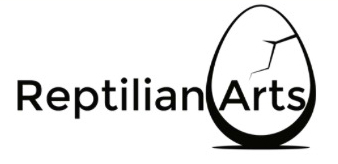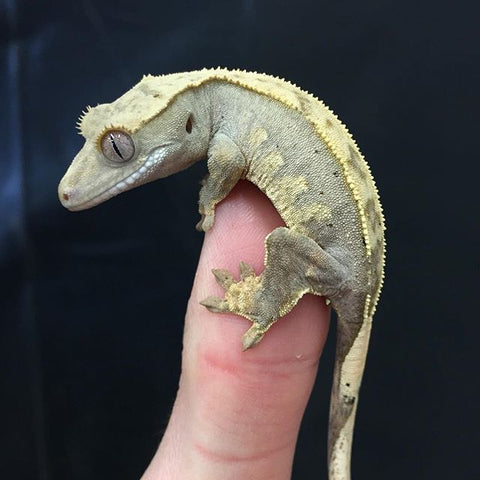Crested Gecko Care
Basic Information
Crested geckos are a unique, beginner-friendly reptile widely available in the reptile community. Cresteds are named for the fringes along their body and come in various colors and markings. Thanks to their toe pads and unique tails, they are great climbers and even better jumpers. They are fairly docile, although a bit skittish, and are usually quickly used to handling with enough dedication and time. Crested geckos can live up to 15-20 years, making them a fun, long-time pet.
Health
Like many reptiles, crested geckos experience brumation. Brumation is common in the colder months, and owners may notice their gecko not eating as often or refusing meals. This is normal and only a concern if it suddenly starts losing weight or stops eating.
Another common issue that Crested gecko owners may face is a stuck shed. A stuck shed happens when the humidity levels get too low, and the gecko cannot naturally peel off its own shed. A simple remedy is to mist the enclosure to provide a more humid environment for the gecko to shed in. If the stuck shed persists, soaking it in a shallow bin of warm water for 15-30 minutes is recommended. **Be very careful, as stuck shed and eye caps are a big possibility for geckos. This can result in losing limbs and eyes, so monitor every shed cycle to ensure no difficulties.
Geckos need a supplement of calcium and D3 in their diet every so often, which can be done by dusting their regularly consumed insects or food. Otherwise, they can develop metabolic bone disease or MBD. This can look like deformed or weakened limbs and a weaker jaw, which can prevent the gecko from being able to eat properly. Increase calcium and D3 intake as needed. **It is recommended that their food is dusted weekly with calcium/D3 supplement.
Do not ever handle a gecko by its tail. They will drop their tails if stressed or handled roughly. While most gecko species eventually grow back their tails, crested geckos do not, so handle them carefully.
Enclosures
For crested geckos, prioritize height over length. An adult crested is recommended to be kept in a 20-gallon vivarium, while a juvenile can be kept in a 10-gallon vivarium, although they will need to be kept in a bigger size when they reach adulthood. The top should have a screen opening for ventilation, and the enclosure should be located away from any direct sunlight or heat source. Crested geckos are climbers by nature, so fill the vivarium with different branches and plants for climbing and hiding. Be sure to place items at different levels in the vivarium so some objects are in and out of the basking zone.
Heating/Lighting
The enclosure should stay around 70-75 Fahrenheit. A UVB bulb is unnecessary for a crested as they should get all they need from their diet. Cresteds are more nocturnal, so to simulate nighttime for the gecko, turn the lights off at night. A heat mat can help keep the enclosure at optimal temperature if the room gets colder at night, but it must be used carefully to ensure the gecko doesn’t overheat. A timer can help turn the heat mat on and off to prevent overheating. Use a thermometer with probes on both ends of the enclosure to monitor the hot and cool ends. *Be sure not to use a strong light emitting bulb as geckos have sensitive eyes and are susceptible to eye damage and stress.
Substrate
When selecting a substrate for a crested gecko’s enclosure, it is important to consider the high humidity demand. This means the substrate needs to hold humidity well while not being prone to mold. A good option is coconut fiber, which can be used with a layering of sphagnum moss. Another simple option is a layer of moist paper towels on the bottom; this option is also recommended for juvenile cresteds.
Humidity
Cresteds prefer a humidity level between 70% and 80% in their enclosure to reflect tropical environments. The substrate should be frequently checked because of the high humidity required to ensure no mold develops. A light misting daily helps maintain the humidity levels. A humidity hide full of moist substrate like sphagnum moss is also ideal for providing a humid spot for shedding. Use a hygrometer to monitor humidity levels.
Water
Crested Geckos need a constant water source, so provide a shallow dish of fresh water at all times. Replace and clean daily.
Food
Crested geckos differ from other gecko species in terms of diet. While they are insectivores, crested geckos thrive better from a powder mix specifically made for them. A pangea powder mix meets many of the nutritional needs of a crested gecko, is readily available in many stores, and comes in many flavors of fruit and insects. Simply mix it with water, put it in a small dish, and replace it every few days to prevent mold. While they can eat insects and regularly do in the wild, in captivity, it's better to give them insects once a week rather than as a standard diet option. Gut-loaded insects like dubia roaches, waxworms, and mealworms are recommended. Calcium/D3 powder is also recommended as a supplement when feeding insects. Sweet fruit baby foods can also be offered as a treat with pangea.
Have another question? Contact Us

